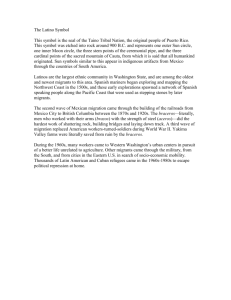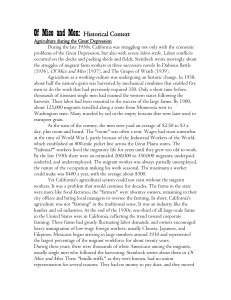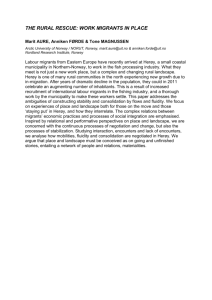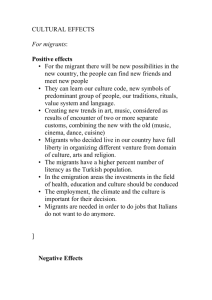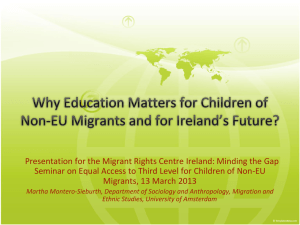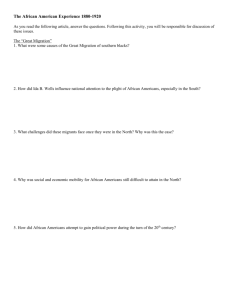Listening to African migrant voices: a research project to record
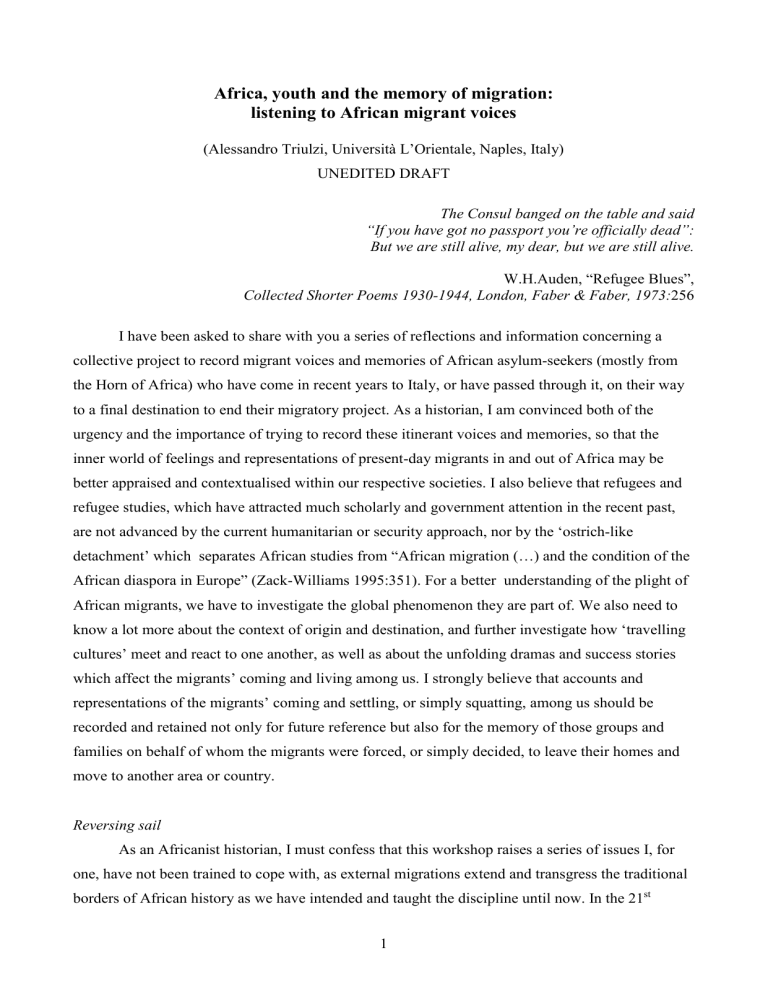
Africa, youth and the memory of migration: listening to African migrant voices
(Alessandro Triulzi, Università L’Orientale, Naples, Italy)
UNEDITED DRAFT
The Consul banged on the table and said
“If you have got no passport you’re officially dead”:
But we are still alive, my dear, but we are still alive.
W.H.Auden, “Refugee Blues”,
Collected Shorter Poems 1930-1944, London, Faber & Faber, 1973: 256
I have been asked to share with you a series of reflections and information concerning a collective project to record migrant voices and memories of African asylum-seekers (mostly from the Horn of Africa) who have come in recent years to Italy, or have passed through it, on their way to a final destination to end their migratory project. As a historian, I am convinced both of the urgency and the importance of trying to record these itinerant voices and memories, so that the inner world of feelings and representations of present-day migrants in and out of Africa may be better appraised and contextualised within our respective societies. I also believe that refugees and refugee studies, which have attracted much scholarly and government attention in the recent past, are not advanced by the current humanitarian or security approach, nor by the ‘ostrich-like detachment’ which separates African studies from “African migration (…) and the condition of the
African diaspora in Europe” (Zack-Williams 1995:351). For a better understanding of the plight of
African migrants, we have to investigate the global phenomenon they are part of. We also need to know a lot more about the context of origin and destination, and further investigate how ‘travelling cultures’ meet and react to one another, as well as about the unfolding dramas and success stories which affect the migrants’ coming and living among us. I strongly believe that accounts and representations of the migrants’ coming and settling, or simply squatting, among us should be recorded and retained not only for future reference but also for the memory of those groups and families on behalf of whom the migrants were forced, or simply decided, to leave their homes and move to another area or country.
Reversing sail
As an Africanist historian, I must confess that this workshop raises a series of issues I, for one, have not been trained to cope with, as external migrations extend and transgress the traditional borders of African history as we have intended and taught the discipline until now. In the 21 st
1
century, historians of Africa are being called in to explore the ‘out of Africa’ processes which have shaped the continent’s peoples and their plight in history (Gomez 2005). Yet, in spite of the fact that
Africans have always been ‘on the move’ (Amin 1995, Apokpari 1999), we have been trained to do local, regional or continental histories, whether of states, polities or societies, as self-contained units of analysis - ‘top down’ or par-le-bas - investigating local agency vis-à-vis internal or external forms of autocracy or domination - but always focussing on peoples and societies of Africa and in
Africa. It is not just anthropologists, but historians as well, who have a ‘sedentarist analytical bias’ in their reading of these processes (Malkki 1995:508), as they appear to have concerned themselves more with the growth and decline of states, localities, institutions or cultures rather than with peoples’ movements and migrations in a trans-local, trans-national, trans-spatial way. In the light of the present waves of population movements, it is high time that we reverse sail and that migrations and migrants become part of our daily scholarly, and not only humanitarian concerns.
The acceleration of trans-national migratory waves in the global world we live in - it was estimated in the mid-1990s that some 300 million ‘Africans’ lived worldwide compared with 540 million residents in Africa (van der Veer 1995) - has forced social scientists, planners and bureaucrats to deal with this problem and find solutions and remedies which almost everywhere
(not just within the EU) have gone in the direction of more control, restrictive access, increased security, abuse of civil rights, and a general tightening of state frontiers and citizenship rights.
Today the migratory world is much talked about and debated - both in European and African societies - and is acted upon and researched by endless cohorts of scholars, government agencies,
Ngos and international experts. Yet I feel historians of Africa have been reluctant or unable so far to involve themselves in the study of trans-national movements of peoples both inside and outside the
African continent, with the notable exception of the Atlantic slave trade (Mohan & Zack Williams
2002). Even internal migrations and displacements of peoples have been little researched in historical terms, and anthropological, cultural or literary studies of trans-locality (called at times postcolonial studies) far outweigh historical research on mobility, migrations and trans-nationalism in Africa. African history has been rather more successful in studying well-contained units through time than open-ended movements of peoples and ideas and their inter-relationship with moving spaces.
Border crossing
There are several reasons which, in my opinion, justify a more active involvement of
African and Africanist social scientists in the global migratory issue, and make our discussions at this workshop quite relevant for our respective studies. First, I believe that today’s African internal
2
and external migrations are part and parcel of African history, and that national histories of African communities (as well as their growth, rate and quality of development, and the prevalence of peace or conflict) cannot any longer be understood or explained without including trans-national movements and flows of people, money, goods and ideas (Akyeampong 2000, Byfield 2000,
Patterson and Kelley 2000). I also believe, to put it briefly, that the present migrations to (and through) the Mediterranean, the Middle East and southern European countries (such as Algeria,
Libya, Turkey, or Greece, Italy, and Spain) are the result not only of desperate ‘exit options’ by people who have no other way of coping with the pressures of the present, but are increasingly the result of rational decisions by people who simply decided they wanted to broaden their outreach and range of options in life. These ‘new’ migrants are embedded into social, economic and kinship networks which are of extreme importance in sustaining and attracting migratory waves (Grillo
2000).
I also share the view of those who consider trans-national migrations - from business operators to downtrodden asylum-seekers or work-hungry people - a major challenge to the prevailing economic, political and philosophical models of state-making and citizenship, hence the constant effort to ‘de-politicise’ them at state level (Malkki 1995:509-10; Pérouse 2002). In this sense, today’s transnational migrants are putting to the test national or state identities and question the very roots of our belonging to one country, language, race or ethnic group. Trans-border cultures need not be just ‘open wounds’ to be healed but can help us to renew and extend the closed-in social contract we inherited from the nation-state and its strictly-bound frontiers.
It is for all these reasons that I believe there is an urgent need to record, document and bear witness to this global process through the voice of its participants, actors and eye-witnesses.
Whether they are victors or victims, whether they are able to pursue their migratory project to the end or not, their failure or success will be influenced not only by the contingencies of today’s volatile international relations, but also by the way we, as scholars, are able to record and analyse the daily practices and representations of what appears to be the first wave of mass global migration in world history.
Having said this, I must confess that at my age and contained research experience it is not so easy to remould one’s own skills and human limits. This is not the first time I am de-routing from the well-trodden path of my discipline (history) and terrain (nineteenth and twentieth century
Ethiopia). As a graduate student doing fieldwork in western Ethiopia and southern Sudan in the early 1970s, I had to cross several geographical, linguistic and mental borders before understanding the historical growth of a small ‘no-man’s land’ (a slave and gold district called Beni Shangul in western Ethiopia, now a minor and neglected ‘state’ of federal Ethiopia) whose local inhabitants
3
(and identities) stretched over Ethiopia and Sudan. At that time, one did not pay much attention to the western Ethio-Sudanese border – “Frontiers used not to be marked on maps, and were scarcely more visible as one passed across them” (James 2002: 259) - and I was able to record trans-border histories of domination and resistance in an area whose wealth and people were equally coveted and raided by both the Mahdist State and Menelik’s Ethiopia. The coming of the Derg’s rule in
Ethiopia and the following period of state and interstate crisis put an early end to my cross-border research of Ethiopia’s outer limit. So, moved by internal events in Ethiopia, I ‘migrated’ to other topics: first, I dug up archival source collections, oral and written, then immersed myself in visual records (mainly colonial photography), and finally ended up with carrying a comparative research on ethnic conflict and political constructions in contemporary societies. When I went back to the field in Ethiopia in the mid 1990s, I was soon caught up in another unexpected detour: the lingering conflict between Eritrea, now a fully independent state, and federal Ethiopia which dramatically surfaced on the occasion of the long and still unsettled border war between the two countries
(Triulzi 2006). So, in a way, borders have haunted me as a researcher all my life.
In the Horn, borders are today haunting people as well. In the past ten years or so, the region of the Horn has witness an unending series of man-made and natural disasters: repeated drought throughout the region, genocidal practices (in Darfur), cross-border and internal guerrilla warfare
(Southern Sudan and Ethiopia), a lengthy state of war over the demarcation of a colonial boundary
(Ethiopia-Eritrea) and, more recently, terrorist threats and counter-terrorist military operations (in
Somalia). The 1998-2000 conflict between Ethiopia and Eritrea caused no less than 100,000 casualties and over half a million people were displaced. The culture of war which ensued, coupled with increasing insecurity and political stagnation, led many people, youngsters in particular, to abandon their country to escape forced recruiting and economic deprivation. Since then, border crossing has no longer been an ‘innocent’ activity in this part of the world. Governments are making difficult for people to leave, parents are to pay fines or go to prison if their sons and daughters try to elude their military duties by escaping to another country - to be expelled or arrested again by the countries they escape to for illegally entering them. Moving is becoming an increasingly transgressive activity, both in Africa and in the West. Migration is inevitably part of this global mass transgression.
Migrating, transgressing
Cross-bordering has always implied, to a certain extent, transgressing. It is true for migrants crossing neighbouring countries and for those travelling to far-away ones. It is particularly true for the ambiguous and ever-increasing category of asylum seekers who – in my country – are
4
considered illegal and clandestine until they can prove their rights to refugee status, a ‘right’ which is often difficult to prove within the existing Geneva-influenced norms of political asylum. To be
‘clandestine’ – a condition which affects most African migrants in Europe nowadays - implies not only the usual need to conform to social habits, language and appearance which are accepted or prescribed by the host societies, but implies as well the subjecting of oneself to various forms of camouflage, the hiding of one’s own origin or acquiring a different one which is thought to lead to more rightful entitlements to refugee status.
Maintaining one’s own identity can be risky or impossible in such conditions, as it may clash with the ‘legitimate’ identity as perceived by the recipient country’s authorities. One’s ethnic, religious or political belonging, and the real motifs for departing or for wanting to stay, thus become more inscrutable and ‘enigmatic’ than ever both for state authorities and for the fleeing clandestine population. So migrants and asylum seekers are often forced to keep their real nature and expectations as an undisclosable truth, something which – like the marranos or conversos of 15 th century Spain – they hold inside as an ‘unchosen’ secret which ‘holds’ them at the same time
(Derrida 1996). Here lies the ‘open wound’ ( herida abierta
) vividly described by Gloria Anzaldùa, of all border cultures: “Its inhabitants constitute what is prohibited and forbidden. Here live los atraversados [those who cross over]: the malignant, the perverts, the homosexuals, those who bother, the bastards, the half-caste, the half-blood, the half-dead; in a word those who cross, go beyond, overcome the borders of normality” (Anzaldùa 2006:29).
Migrants are often perceived as transgressors. Indeed, as the Latin word for migrate
( migrare) implies, the migratio denotes not only the act of moving or displacing but the very idea of
‘trespassing rules and customs’:
communia iura migrare (Cicero, De divinatione , I, 8, in Vitale
2004:30). Migrants always live ‘at the border’ even when they are deep inside another country, torn between the ‘here and there’ of their multiple being - their identity, not just their body, being literally ‘on the move’ (Frederiksen & Sørensen 2002). This explains both the difficulties of state authorities to extract ‘true’ statements concerning the migrants’ ‘real’ reasons for coming and wanting to live in another country, as well as their reticence, their suspicious silence, their inability or unwillingness to express their inner self, to tell the true story of their life, their personal odyssey.
According to most institutional bodies, including international ones, the ‘naked nature’ of man is yet be considered part of homo sacer and his inner rights (Agamben 1995), as states abide by rules and regulations which are derived from internal or international law, not philosophical norms.
This implies that most illegal migrants – particularly those of young age – live in the host countries not only in a de-territorialised but totally de-humanised solitude. In their inability to orient themselves in an alien universe of cryptic signs and messages, they are led to suppress their ‘alien-
5
ness’ by cancelling, hiding, changing or denying their country, ethnic group or original home in their strenuous effort to come to terms with the internal or international norms of the host country.
Not allowed to be what they are, they strive to conform themselves to the accepted identities, origins, or troubled areas of the world, which they believe it will facilitate their being granted asylum or given a work or living permit. The continued transgression and hiding of the foreign migrant, his sense of solitude and shame for always ‘appearing’ rather than ‘being’, makes his marrano -like figure akin to the position of all false converts ( conversos ): they have to hide something they cannot disclose, and their very ‘mimicry’ (Bhabha 1997) is used against them. This is why, in most European countries today, particularly in places like Italy and Spain where the number of migrants have dramatically increased in the last five years, migrants are made illegal by our own restrictive norms of inclusion and bureaucratic entanglements transforming them in most cases as gastarbeiter , or foreign workers without rights, to the benefit of informal and illegal networks operating in the market.
Recent research among asylum seekers from the Horn of Africa in Italy (Koser 2003,
Arnone 2005), Egypt and Sudan (Le Houérou 2004) have also shown that the new generation of
Eritrean and Ethiopian youths escaping their respective countries for fear of war and political repression do not fit current standards for their being granted asylum status. Most of their requests are rejected on the principle that they are based on ‘economic’ and not ‘political’ motivations. I have no time to deal here with this highly complex issue, except by stating that it is extremely difficult to differentiate nowadays between these two falsely-opposed motivations, since political and economic situation in the region of the Horn as elsewhere is inextricably interwoven.
Furthermore, what is perhaps even more disquieting, research has shown a real antagonism between the first generation of migrants from the Horn who came to Italy in the 1960-1970s and the present generation of youths escaping military recruitment and a future of no economic or political prospect.
To the old generations of Eritreans who came to Italy at the time of the war of liberation
(which ended successfully in 1991) their opting out of the country at war was perceived as an alternative way of participating in the liberation of the country, a different but legitimate engagement with war times. The new youths aspiring today to a brighter future and eluding the country’s military duties are perceived by the second generation migrants as useless hooligans and
‘traitors’ to the country’s cause. Thus, a generational conflict is piled up over a major political and economic gap by which ‘those who made it’ express anxieties over the destabilising effect of the
‘poor and idle’ new comers, while ‘those who hope to make it’ reject both the nationalist call of their elders and the exclusionist policies of the Italian authorities. A whole circuit of ‘narratives’
6
and ‘counternarratives’ are enacted at different levels by the older and younger generations (Arnone
2005)
A similar interplay of false ‘truths’ is enacted by the very mechanism of asylum itself within
Europe. As Terence Ranger has shown recently for Zimbabwean refugees in England (Ranger
2005), both the asylum seekers’ narratives presented to the Home Office adjudicators – guided by
“solicitors and the ‘street wisdom’ of other asylum seekers on what they think the adjudicators want to hear” - and the uniformly-drafted Home Office ‘counter-narrative’ of refusal are ‘flawed documents’ which need close investigation of the new ‘postcolonial encounter’. Recent research carried in Rome among asylum seekers from the Horn bears the same flawed evidence (Triulzi in press). Clearly, there is need for all of us to rethink the inherent modes and causes for such institutional transgression. Equally, there is need for locating different ways of listening to migrant voices trying to escape both official truths and self-imposed denials.
The illegally-occupied Tiburtina warehouse in Rome inhabited by clandestine migrants from the Horn of Africa has unexpectedly afforded one of them. Two years ago, when I was called by a friend of mine who was teaching Italian to African migrants to see if I would help asylum seekers who were to be summed by Government adjudicators to obtain refugee status in Italy, I realised I was not just being offered a way to show solidarity to African migrants but, as a researcher, I was faced with a whole new set of issues which confronted my own historical métier no less than my own society’s inability to cope with the demands and challenges posed by the African migrants. So
I joined in and took part in the Italian school activities to familiarise myself with individual faces and histories, to learn how to cope with people who had been traumatised physically as well as spiritually, and were often unable or unwilling to narrate or even express their vicissitudes and untold suffering and anxiety. From the school premises, one room in a crowded apartment where a local Italian NGO (Doctors against Torture) received patients and helped them to cope with the painful memories of violence, I was eventually led to the place the migrants lived in, a huge vacant three-storey warehouse belonging to the Italian Railway which had been occupied by people mainly from Sudan, Eritrea and Ethiopia. It is perhaps good to start from here, Tiburtina, the migrants’ new
‘home’, to introduce you now to the actual context of my current research.
Making a home at Tiburtina
Tiburtina derives its name from the close-by Tiburtina Railway Station. Surrounded by a high wall, an iron net and a locked gate, migrants found their way there following the railway lines at night looking for a place to sleep. Eventually they broke in through the thick wall by climbing over it with a ladder and digging a circular hole one had to lower one’s head to go through.
7
Surrounded by a large wasteland of trampled dusty earth, the building stood high in its incomprehensive emptiness. For five years (1999-2004), through lengthy negotiations with the
Railway and Township authorities, and a hard-won agreement with the different migrant communities, they were allowed to stay as temporary squatters. There were no light, water or hygienic facilities inside, although these were sparingly provided by the authorities outside the building. The authorities paid little attention to Tiburtina until NGOs and journalists were called in to help, report and protest. By then, most of the self-made internal structuring of the Tiburtina warehouse had been worked over by the migrants. At its peak, the warehouse was able to host about
500 migrants neatly divided into crammed partitions or cells (‘rooms’) each family or individual migrant being free to structure on his own by opening windows, raising flimsy walls, laying tables or beds with whatever they could lay their hands on, cardboard, cloth or tile. To the Italian public, the place came to be known (through the uncanny rhetoric of scoop-hungry journalists) as ‘Hotel
Africa’.
Migrants refused this heteronym: Everybody now knows Tiburtina as Hotel Africa, but for us who live here, it is simply Tiburtina. We don’t like Hotel Africa because you cannot call a place without water or light a hotel... Tiburtina is not a hotel and it is not Africa, it is Italy.
(Field Notes,
7) So they kept referring to it as Tiburtina when speaking to foreigners. Among them, they used the term kerba , or ‘abandoned house’, the ‘house of house-less persons’ (Id., 7, 49), a squatting place for illegal workers, foreigners without rights, ‘metics’ of some sort (Ciafaloni 2005-06). Yet
Tiburtina fulfilled, under most difficult circumstances, its the role of sheltering the ‘homeless’ and
‘stateless’ by providing material protection, food and a roof over their head, as well as nurturing a well-grounded feeling of togetherness out of common needs, ties of kinship, and shared longings.
However temporary and squalid the new ‘house’ was, it was all the migrants had, and they stuck to it striving to make it as much as possible their ‘homing’, or craving for a substitute home.
It is interesting to see - and our research aims at recording it - how this came about, from the first group of 25 Sudanese refugees who discovered Tiburtina walking along the rails at night looking for a place to sleep. Here are some of the stories we recorded:
We Sudanese thought only of two countries, England and Holland. The road took us here, to
Italy. Nobody knows Italy, for us it is only transit, we had no one here in Italy, we were the first.
(Id., 47)
The upper floor was still empty. As new persons came in, we built the rooms. I made the first room on the first floor, the one at the end corner. We found some large pieces of cloth and we divided the space. Bit by bit, we found old mattresses, iron beds and all the rest.
(Dighel,
49)
8
When I first arrived at Tiburtina and saw it, the first thing I thought was I want to leave, to go away, I had no other thought but that. (Id., 48)
Yet in time Tiburtina became something else. Created out of nothing through migrant inventiveness, adaptation, and ability to cope within hostile surroundings, it soon revealed the depth of social capital at the disposal of migrant groups. It soon became a ‘transnational space’ endowed with a new geography of fulfilled material needs, kinship ties and sociability. In the absence of state intervention, and societal indifference, a creative process of home-building took place which was interrupted by the media who dubbed it ‘Hotel Africa’, and a period of brief governance by church, state and NGO interventions which eventually led to the evacuation of its occupants. Life in Tiburtina, during its brief heyday as a multiethnic house, is described below by those who found the comforts of “home away from home” for the different refugee communities:
When one arrives one is zero, no money, no nothing. When I arrive here I find people, they say hello to me, you are a Sudanese, only this counts. All come and bring me things reserved for guests, eat, drink, they ask me how I feel, how I came, where I came from, what problems I met, they allow me into their circle so that I do not feel that I am an outsider, as if I had known them for a long time. I ask information to know whether I should stay or go to another country. I ask how the situation is here. They give me all the information: police, school, the public mess, the reception centre, work possibilities. If I want to leave they give me information how to go away. They take me to the station, they buy the ticket. If I don’t have money, they put together the money for it.
(Id., 47)
If you work at a petrol station, you go out late at night and come back during the night. So you cannot go and sleep at the Township’s reception centre, because there you are obliged to get in within a certain hour otherwise your bed is taken. It was for this reason that we chose to live at Tiburtina, so that we could go out at night and work at petrol stations… We did not want to sleep in a refugee centre, nor eat at the Caritas’ mess. To eat there you always have to queue up and you feel sick too if you have to wait in line to eat, it is bad for us, we are young, we can work and do things ourselves… Even to go to school, to make an appointment, to see friends, the centre and the mess are no good, you always have to think about their timing, you cannot decide whether you can do one thing or the other. At
Tiburtina you can come and go as you please, you can make things normal.
(Id., 48)
9
To make things normal was, for the Tiburtina dwellers, to be able to reconstruct as far as possible a human environment where they could re-locate themselves and reconstruct their social identity as migrating humans. It became a resting place for people on the move needing a human setting where wounds and suffering and memories could be healed, feelings of friendship and belonging could be renewed, projects of further migrancy developed or renovated on the basis of their own knowledge, individual emotions and joint needs, so as to feed the continuous ability to forge new networks of solidarity and mutual indebtedness. Not all succeeded, of course, and to some Tiburtina was simply a place of refuge and isolation from a hostile world, a place to withdraw to and get drunk or simply lie back:
One should not stay too long here. It is good as a place of arrival and departure but if you stay here for one, two or three years, then you’ll get sick…After a while…you risk spending all your time thinking about your life, you keep thinking while time goes on and on. Little by little you risk losing the strength to do all that is asked from you, so you get sick, start drinking and then you feel even worse.
If you are afraid, Tiburtina protects you, it is a place where you can disappear. Often I want to stay by myself and want only to think, and don’t want to go out at all... When I am out of
Tiburtina I feel I am in Italy, but when I am inside I feel I am still in Africa (Id., 8)
Communal life helped and in some measure healed. Seen from theoutside, the compound and its surroundings presented the familiar sight of any crowded favela or brisk bidonville of an
African town: during the day, one could see women chatting, washing, ironing, cooking, feeding babies, while men held conversations or trade deals on broken chairs and discarded furniture.
Inside the building at all times “there is a constant shuffling of people, some mend a broken door or a room partition, here and there people group together around a card playing table, the outside wash basins are always crowded with persons washing their teeth, face, feet, clothes or shoes, they fill buckets, pots or bowls with water which they carry on shopping trolleys…
Someone gets shaved, is having a hair cut or dyes his hair… At any time during the day people play pinball. Around there is the Sudanese restaurant of Adam, the grocery and the laundry of al-Faki and Ciolle, the broad-bean and, during Summer, the milk-shake kiosk of Saleh; above, on the first floor, there is the Eritrean coffee shop of Said…” (FN, 12)
The feeling of belonging to one migrant community englobing the various ethnic groups was ensured at higher level by formal committees of elected representatives on an ethnic basis and, in a more informal and spontaneous way, by specially trusted persons within each community who made sure that relations developed along negotiated dealings of give and take. It was this
10
constant mediation of disparate needs and identities of people arriving and leaving along different migratory projects, only needing a place to stop-over and a junction from which to branch off in different directions, which made the self-organised Tiburtina non-lieu an irreplaceable ‘trans-national space’ which showed the migrants’ abilities to shape, construct, adapt and mould, if only allowed, their own world of reference, solidarity and exchange.
After the journalists re-named Tiburtina ‘Hotel Africa’, and the area became a constant spot of social and curio sight-seeing, the State and a plethora of well-meaning bureaucrats arrived. It was (i.e., they ) decided that Tiburtina was to close down (too unhealthy, too free, too left on its own to be sustainable) and the Railway was allowed to re-appropriate itself of the abandoned
Tiburtina warehouse and its premises. It was then that a group of us decided that the story of
Tiburtina should be recorded and as far as possible documented through the eyes of its actors.
The project started a year ago as a collective research aimed at showing the potential of migrant groups for self-organising and managing self-run trans-national spaces. It also wanted to stress the importance of recording the accumulated experience of a collective effort of this kind as a guide, and possibly for the revision of state and private policies of reception and assistance to refugees in Italy.
The interviews and exchanges we have had so far with Tiburtina migrants at the Italian school have also shown the importance of creating an atmosphere of mutual trust and respect between the narrator and her/his listening audience in order to record not only the movement of migrants in one’s own country of residence but also to enter into the more intricate world of the home they left, the feelings and motives surrounding their departures, the irksome and often painful journey which led them to other shores. I suggest we badly need to record and analyse the all and sundry Tiburtinas of the contemporary age if we want to give some depth and historical record to one of the main rites of passage and painful ‘initiations’ of the world’s increasing migrant population.
11
REFERENCES
G. Agamben (1995) Homo Sacer. Il potere sovrano e la nuda vita , Turin: Einaudi
E. Akyeampong (2000) “Africans in the Daspora: The Diaspora and Africa”, African Affaire ,
99:183-215.
S. Amin (1995)
“Migrations in Contemporary Africa: A Retrospective View”, in J.
Baker, T.A. Aina, eds. The Migration Experience in Africa , NAI,
Uppsala
J.K. Apopkari (1999)
“The Political Economy of Migration in Sub-Saharan Africa”,
African
Sociological Review , 3, 1
G. Anzaldùa (2006)
Terre di confine. La frontiera , Bari: Palomar
A. Arnone (2005)
K. Bhabha (1997)
“I viaggi verso l’esilio: l’elaborazione dell’identità eritrea tra esperienza e narrazione”, in Riccio 2005:82-95.
“Of Mimicry and Man. The ambivalence of colonial discourse”, in F.
Cooper, A. L. Stoler (eds), Tensions of Empires , Berkeley, Los
Angeles, London: The University of California Press, 152-160.
J. Byfield (ed) (2000) “Rethinking the African Daspora”, African Studies Review, 43,1
F. Ciafaloni (2005-06) “Meteci”, Lo straniero 66/67: 98-105.
J. Derrida (1996) Apories. Mourir –s’attendre aux ‘ limites de la verité’ , Paris: Ed.
Galilée
FN (draft) “a tiburtina giù la piazza più nessuno”, extracts, documents and field notes ed. by Marco Carsetti, draft
B.F. Frederiksen, N.N. Sørensen (eds) 2002
Beyond Home and Exile: Making Sense of Lives on the Move , IDS Occasional Paper 23, Roskilde, 5-14.
M.A. Gomez (2005) Reversing Sail. A History of the African Diaspora , Cambridge:
Cambridge University Press
R. Grillo (2000) “Riflessioni sull’approccio transnazionale alle migrazioni”, in Riccio
2000: 9-16.
W. James (2002) “No Place to Hide. Flag Wawing on the Western Frontier” in W.
James, D.L. Donham, E. Kurimoto, A. Triulzi (eds)
Ethiopia. Socialism and After
Remapping
, James Currey, Oxford, 259-275.
12
K.Koser (2003)
“Mobilizing New African Diasporas. An Eritrean Case Study”, in K.
Koser (ed), New African Diasporas , London and New York:
Routledge
F. Le Houérou (2004) Migrants forces éthiopiens et érythréens en Egypte et au Soudan
,
L’Harmattan, Paris.
L. H. Malkki (1995) “Refugees and Exile: From ‘Refugee Studies’ to the National Order of
Things”,
Annual Review of Anthropology , 24
G. Mohan, A. Zack-Williams (eds) (2002) “Africa, the African Diaspora and Development”,
Review of African Political Economy , 92
T. Patterson, R. Kelley (2000) “Unfinished Migrations: Reflections on the African Diaspora and the Making of the Modern World”,
African Studies Review , 43, 1
M. Pérouse de Montclos (ed) (2002) “Réfugiés, exodes et politique”,
Politique africane , 85,
‘Introduction?, 5-15.
T.O. Ranger (2005)
“The Narratives and Counter-narratives of Zimbabwean Asylum: female voices”, Third World Quarterly , 26,3
B. Riccio (2000)
“Emigrare, immigrare, transmigare”,
Afriche e orienti , 2, 3-4: 4-40.
B. Riccio (ed. 2005) “Migranti africani in Italia: etnografie”, Afriche e orienti , 8, 3:12-132.
P. Van der Veer (1995) “Introduction: The Diasporic Imagination”, in P. Van der Veer (ed),
Nation and Migration: The Politics of space in the South Asian diaspora , Philadelphia: Philadelphia University Press, 1-16.
A. Triulzi (2006)
A. Triulzi (in press)
“The past as a contested territory: commemorating new sites of memory in war-torn Ethiopia”, in Preben Kaarsholm (ed),
Political Cultures and Development
Violence,
, Oxford, James Currey, 122-138.
“Ascoltare voci migranti: riflessioni intorno alle memorie di rifugiati dal Corno d’Africa”, afriche & orienti , 8, 1 (in press)
E. Vitale (2004) Ius migrandi. Figure di erranti al di qua della cosmopoli,
Boringhieri, Torino.
Bollati
A. Zack-Williams (1995) “African Development and African Diaspora: Separate Concerns?”,
Review of African Political Economy , 65
13

